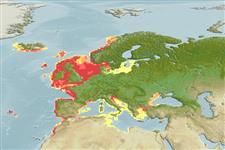Common names from other countries
Environment: milieu / climate zone / depth range / distribution range
Ecologie
; diepteverspreiding 0 - 150 m (Ref. 4), usually ? - 50 m (Ref. 4). Subtropical, preferred 12°C (Ref. 107945); 69°N - 29°N, 28°W - 32°E (Ref. 4)
Eastern Atlantic, Mediterranean and Black Sea. Not in east of Crete and in the Baltic Sea.
Length at first maturity / Size / Gewicht / Leeftijd
Maturity: Lm 8.9, range 8 - 8.3 cm Max length : 65.0 cm TL mannelijk/geslacht niet bekend; (Ref. 441); common length : 40.0 cm TL mannelijk/geslacht niet bekend; (Ref. 441); Maximaal gepubliceerd gewicht: 6.0 kg (Ref. 4); Maximaal vermelde leeftijd: 72 jaren (Ref. 81081)
Common total length: 23 to 50 cm. Occurs on the continental shelf at depths of 0 to 150 m, usually not deeper than 50 m. Found on hard substrates such as rock or hard mud. Nocturnal and territorial living in holes or crevices. Females with eggs are usually found throughout the year. The eggs are laid around July and carried for 10 to 11 months (Ref. 4). Indiscriminate scavengers, omnivorous or carnivorous. Feeds primarily on malacostracan crustaceans, gastropod mollusks, and polychaete annelids; but diet known to include carrion, echinoderms, lamellibranchs and plant matter (Ref. 96319).
Females with eggs are usually found throughout the year. The eggs are laid around July and carried for 10 to 11 months (Ref. 4). Coupling occurs a few days after the female molts (Ref. 80921).
Holthuis, L.B. 1991. (Ref. 4)
Status op de Rode Lijst van het IUCN (Ref. 130435)
Status bij CITES (Ref. 108899)
Not Evaluated
Not Evaluated
Gebruik door de mens
Visserij: van groot commercieel belang; Aquacultuur: experimenteel
FAO - Visserij: landings, soortsprofiel | FishSource | Sea Around Us
Tools
Internet-bronnen
Estimates based on models
Preferred temperature
(Ref.
115969): 7.7 - 13.3, mean 10.4 (based on 494 cells).
Weerstandsvermogen
Hoog, minimale populatieverdubbelingstijd minder dan 15 maanden (K=0.79-1.0; Fec=13,000).
Prior r = 0.37, 95% CL = 0.25 - 0.56, Based on 1 data-limited stock assessment.
Kwetsbaarheid
Moderate to high vulnerability (46 of 100).
